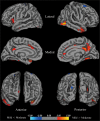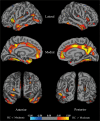Changes in Cortical Thickness in Patients With Early Parkinson's Disease at Different Hoehn and Yahr Stages
- PMID: 30542273
- PMCID: PMC6278611
- DOI: 10.3389/fnhum.2018.00469
Changes in Cortical Thickness in Patients With Early Parkinson's Disease at Different Hoehn and Yahr Stages
Abstract
Objectives: This study was designed to explore changes in cortical thickness in patients with early Parkinson's disease (PD) at different Hoehn and Yahr (H-Y) stages and to demonstrate the association of abnormally altered brain regions with part III of the Unified Parkinson's Disease Rating Scale (UPDRS-III). Materials and Methods: Sixty early PD patients and 29 age- and gender-matched healthy controls (HCs) were enrolled in this study. All PD patients underwent comprehensive clinical and neuropsychological evaluations and 3.0 T magnetic resonance scanning. Patients with H-Y stage ≤1.5 were included in the mild group, and all other patients were included in the moderate group. FreeSurfer software was used to calculate cortical thickness. We assessed the relationship between UPDRS-III and regional changes in cortical thinning, including the bilateral fusiform and the temporal lobe. Results: The average cortical thickness of the temporal pole, fusiform gyrus, insula of the left hemisphere and fusiform gyrus, isthmus cingulate cortex, inferior temporal gyrus, middle temporal cortex and posterior cingulate cortex of the right hemisphere exhibited significant decreasing trends in HCs group and PD groups (i.e., the mild group and moderate group). After controlling for the effects of age, gender, and disease duration, the UPDRS-III scores in patients with early PD were correlated with the cortical thickness of the left and right fusiform gyrus and the left temporal pole (p < 0.05). Conclusion: The average cortical thickness of specific brain regions reduced with increasing disease severity in early PD patients at different H-Y stages, and the UPDRS-III scores of early PD patients were correlated with cortical thickness of the bilateral fusiform gyrus and the left temporal pole.
Keywords: FreeSurfer; Hoehn and Yahr stage; Parkinson’s disease; UPDRS part III; magnetic resonance imaging.
Figures



Similar articles
-
Dual-Task Performance and Brain Morphologic Characteristics in Parkinson's Disease.Neurodegener Dis. 2024;24(3-4):106-116. doi: 10.1159/000540393. Epub 2024 Jul 31. Neurodegener Dis. 2024. PMID: 39084207 Free PMC article.
-
Cortical thinning across Parkinson's disease stages and clinical correlates.J Neurol Sci. 2019 Mar 15;398:31-38. doi: 10.1016/j.jns.2019.01.020. Epub 2019 Jan 17. J Neurol Sci. 2019. PMID: 30682518
-
Mapping brain morphology to cognitive deficits: a study on PD-CRS scores in Parkinson's disease with mild cognitive impairment.Front Neuroanat. 2024 Aug 14;18:1362165. doi: 10.3389/fnana.2024.1362165. eCollection 2024. Front Neuroanat. 2024. PMID: 39206076 Free PMC article.
-
Changes in spontaneous brain activity in early Parkinson's disease.Neurosci Lett. 2013 Aug 9;549:24-8. doi: 10.1016/j.neulet.2013.05.080. Epub 2013 Jun 13. Neurosci Lett. 2013. PMID: 23769726
-
Quantitative study of peripapillary retinal nerve fiber layer thickness and peripapillary vessel density in patients with different stages of Parkinson's disease.Int J Ophthalmol. 2023 May 18;16(5):762-769. doi: 10.18240/ijo.2023.05.14. eCollection 2023. Int J Ophthalmol. 2023. PMID: 37206174 Free PMC article.
Cited by
-
Moyamoya Disease With Initial Ischemic or Hemorrhagic Attack Shows Different Brain Structural and Functional Features: A Pilot Study.Front Neurol. 2022 May 13;13:871421. doi: 10.3389/fneur.2022.871421. eCollection 2022. Front Neurol. 2022. PMID: 35645955 Free PMC article.
-
Pleiotropic Association of CACNA1C Variants With Neuropsychiatric Disorders.Schizophr Bull. 2023 Sep 7;49(5):1174-1184. doi: 10.1093/schbul/sbad073. Schizophr Bull. 2023. PMID: 37306960 Free PMC article.
-
Development and validation of a novel model based on hand knob score and white matter injury on MRI to predict hand function in children with cerebral palsy.Ann Transl Med. 2022 Oct;10(20):1102. doi: 10.21037/atm-22-4112. Ann Transl Med. 2022. PMID: 36388818 Free PMC article.
-
Cortical Thickness Estimation in Individuals With Cerebral Small Vessel Disease, Focal Atrophy, and Chronic Stroke Lesions.Front Neurosci. 2020 Dec 14;14:598868. doi: 10.3389/fnins.2020.598868. eCollection 2020. Front Neurosci. 2020. PMID: 33381009 Free PMC article.
-
Meynert nucleus-related cortical thinning in Parkinson's disease with mild cognitive impairment.Quant Imaging Med Surg. 2021 Apr;11(4):1554-1566. doi: 10.21037/qims-20-444. Quant Imaging Med Surg. 2021. PMID: 33816191 Free PMC article.
References
LinkOut - more resources
Full Text Sources

